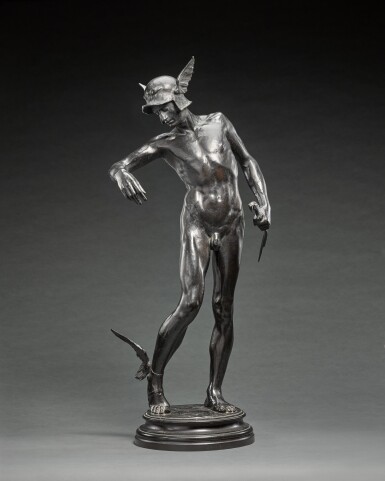
Property from an Important British Private Collection
Alfred Gilbert
Perseus Arming
Lot Closed
July 14, 10:36 AM GMT
Estimate
40,000 - 60,000 GBP
Lot Details
Description
Property from an Important British Private Collection
Alfred Gilbert
1854 - 1934
Perseus Arming
bronze, black patina
73cm., 28¾in.
Douglas Illingworth (1881-1949), United Kingdom;
thence to his wife, Mrs Winifred Illingworth;
sold by order of her attourneys, Sotheby's London, 30 April 1993, lot 181;
where acquired by the present owner
private collection, Chelsea
Perseus Arming is arguably the sculptor's most recognisable and desirable model. The present cast is of the rare largest size, and was originally commissioned directly from the artist by the art collector Douglas Illingworth as part of a rare and complete cycle of Gilbert's oeuvre between 1911 and 1912. The commission is recorded in letters between sculptor and patron which were sold with the bronzes by Illingworth's widow in these rooms on 30 April 1993.
The Perseus comprises one of Gilbert's three ‘autobiographical’ bronzes, the others being –Icarus and Comedy and Tragedy. These three models represent Gilbert during his most creative decade from 1881 to 1892, from his mid-twenties to his maturity in his late thirties. The idea was, as Gilbert described it, to take ‘an old fable’ and move on from the literal text to ‘that which is implied'. Perseus and Icarus have direct mythological reference, whilst Comedy and Tragedy is an original subject with a clear Grecian reference in the mask of Tragedy. As a group their potency is created by Gilbert'’s reinterpretation of classical subjects and artistic references, which whilst being timeless themes, we perceive through Gilbert’'s eyes, thereby making us see them afresh. So, in Perseus' attributes – the winged helmet and sandal –we clearly identify the mythological character, but the moment in which he is represented has no iconographic reference. Here he is shown in a moment of introspection, of vulnerability, of natural unselfconscious eloquence. It is a view of the mythological character which we have never seen before.
Gilbert made his plaster model of Perseus Arming in Rome in the winter of 1880-1 and exhibited the lost-wax bronze cast at the Grosvenor Gallery in 1882. It was received with critical acclaim both in London and at the Paris Salon the following year, where it earned Gilbert an honourable mention and secured his international recognition as the foremost British sculptor of his generation.
Commenting on his success in Paris, Gilbert wrote that it '‘gave me great encouragement to continue the task I had set myself- that was, to go on writing my own history by symbol'’. Gilbert’s description of Perseus Arming continues: '‘I conceived the idea that Perseus before becoming a hero was a mere mortal, and that he had to look to his equipment’ and so Gilbert quite literally depicts Perseus looking over his shoulder to inspect his winged sandal: ‘a youth vulnerable, untested, but equipping himself for the trials of life’'.
As has been noted above, the present bronze (and the preceding lot) were commissioned as part of a rare and complete cycle of Gilbert's oeuvre between 1911 and 1912. These bronzes were commissioned by the art collector Douglas Illingworth and sold by his wife in these rooms on 30 April 1993.
Gilbert placed a number of his models with the Compagnie des Bronzes foundry in Brussels. The foundry archives record that between 1902 and 1918 the main figures supplied were Perseus Arming, Comedy and Tragedy (large and small), and An Offering to Hymen (small). Gilbert oversaw the casting and finishing of the figures himself. It is noticeable that the patina is very dark in each of the Illingworth bronzes and may have been specified by the patron himself.
The present group is referred to twice in correspondence between Illingworth and the sculptor, on 12 February 1912, Bruges: 'The Perseus requires no extra base'.
Douglas Illingworth was born in Yorkshire in 1881, educated at Eton and fought at Gallipoli. Although his main occupation was as a barrister he enjoyed sketching and painting in watercolour. He moved in artistic circles, being a friend of George Clausen, Alfred Rich and James Pride, as well as the sculptor Ernest Gillick who introduced him both to Alfred Gilbert and David McGill. In 1920 he married the opera singer Winifred Radford and commissioned from his friend Meredith Frampton an exquisite portrait of his young bride holding a birdcage. Winifred was the daughter of the opera singer Robert Radford and she made her operatic début as Barberina in the first ever performance at Glyndebourne in 1934, in The Marriage of Figaro. She was sadly widowed in 1949.
RELATED LITERATURE
R. Dorment, Alfred Gilbert, New Haven and London, 1985, pp. 44-46; R. Dorment, Alfred Gilbert Sculptor and Goldsmith, Royal Academy of Arts, London, 1986, pp.106-8, nos 10-11; S. Calloway and L. Federle Orr (eds.), The Cult of Beauty. The Aesthetic Movement 1860-1900, exh. cat. Victoria and Albert Museum, London, 2011, pp. 242-245
You May Also Like










